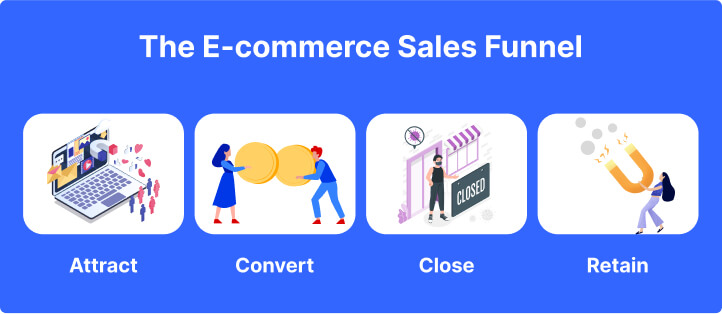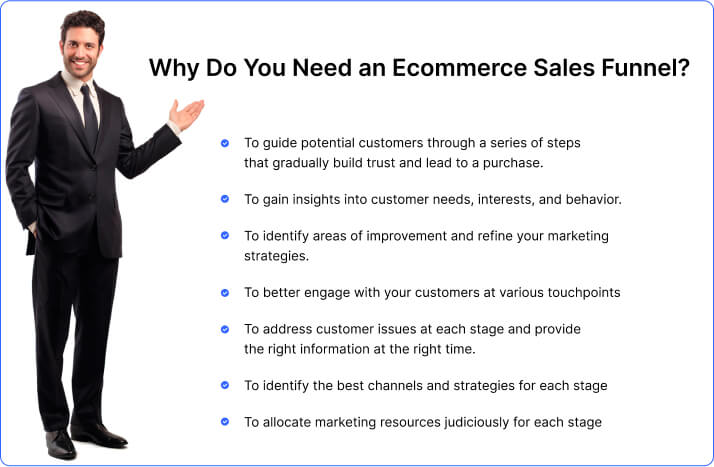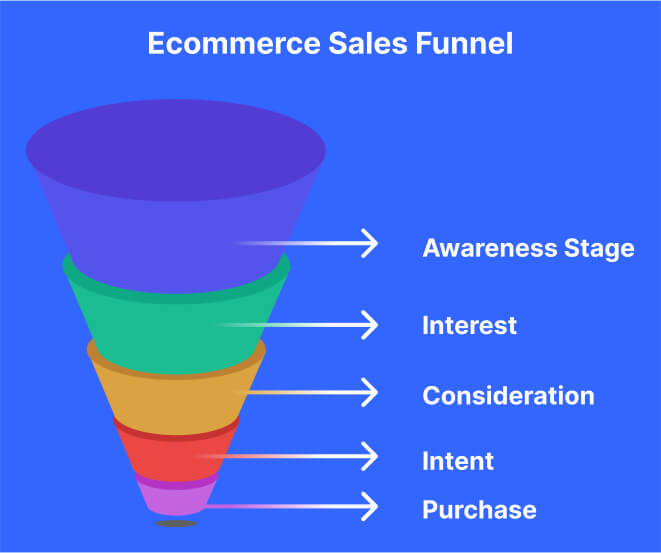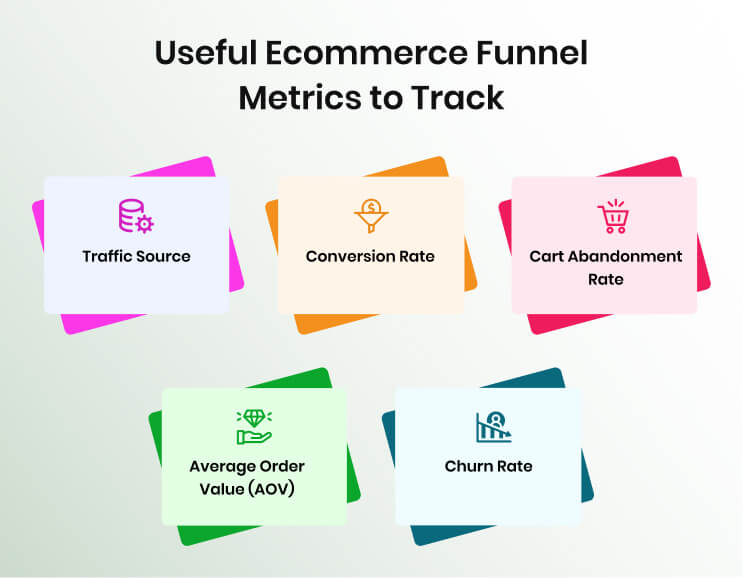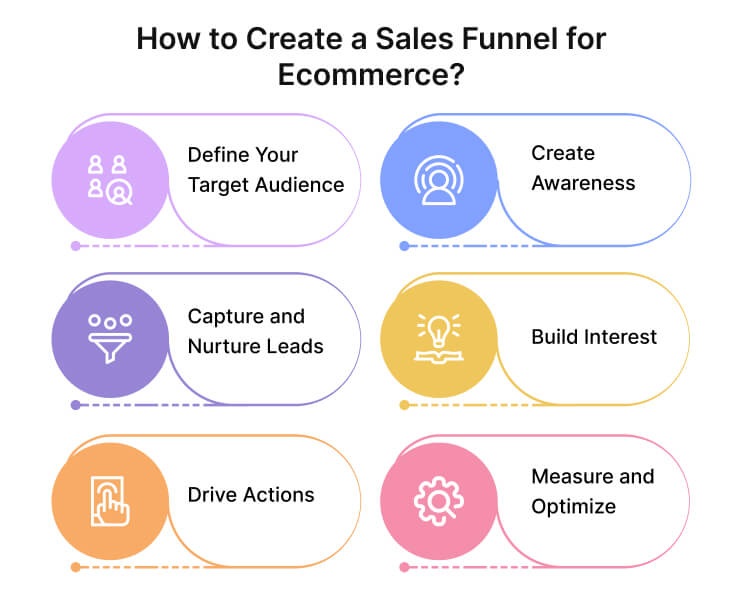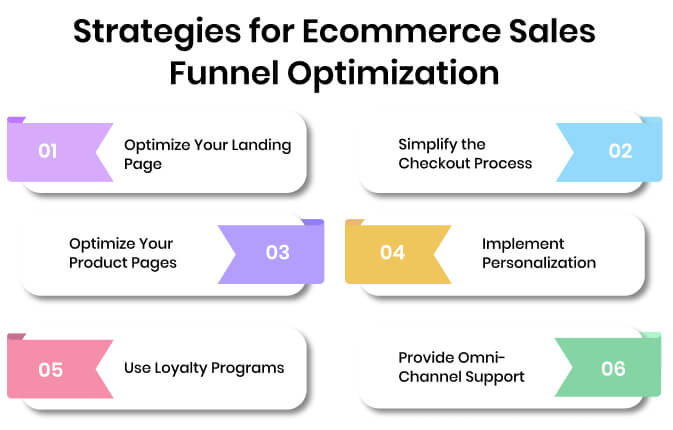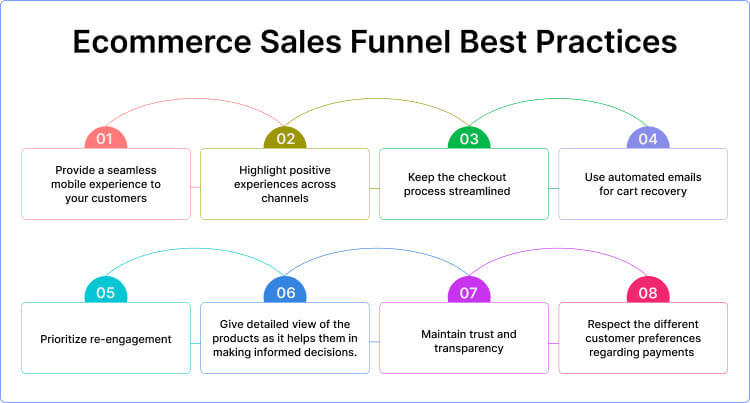When you run an ecommerce business, you may have experienced situations when nothing seems to work. You feel as if all your marketing efforts have failed to produce the kind of conversions, traffic, and sales you expect from your website. This is when you turn to an Ecommerce sales funnel in the hope that it will fix all your problems.
Does it fix?
Well, it does! But how?
Creating a sales funnel for your ecommerce business can help you guide potential customers through a well-structured journey. This can increase the chances of conversion.
More so, when you have created a well-structured conversion funnel, you understand customer needs and pain points better. You know the issues they face at touchpoints during their journey with your brand.
What else do you need more?
So, if you have already invested a significant amount of time and resources in various aspects of the business, you should consider implementing the funnel.
The huge value of the funnel starts when you have done everything else – created a top-quality website, added products, put together persuasive content, and used the right marketing channels.
You can count on the funnel to increase the conversion rate of your website and drive more sales. That’s why creating a sales funnel for your e-commerce business is essential.
In this blog, we will explore the conversion funnel in detail, and understand its definition, various stages, importance, optimization, and examples.
Before moving further, let’s first get started with understanding what an ecommerce sales funnel is…
What is an Ecommerce Sales Funnel?
Before we know the definition of an ecommerce sales funnel, let’s first look at a real-case scenario to understand the concept better.
Have you ever realized the steps customers take in buying from an online store?
Well, first, they hear about a product, see it or analyze it, check it on some website, think about it, read reviews, and compare it with other similar products in the category, before eventually buying it.
From the time they hear about a product to buying it, customers may experience different touchpoints that are planned by the business in advance. So, we can say they are made to go through an ecommerce funnel.
In marketing, a sales funnel is a visual concept that displays the various stages of the customer journey. It’s also a digital representation of your customer’s buyer journey as every individual customer has a unique journey and goes through various stages and makes various decisions.
When the customers first visit your website, they are on top of the funnel and you will try to push them through different stages. This is done to guide them to the bottom, which ultimately materializes into conversion.
This funnel is useful for understanding specific touchpoints, how customers interact at each stage, and the marketing strategies required to convert them.
Why Do You Need an Ecommerce Sales Funnel?
When you run an ecommerce business, your ultimate goal is to convert website visitors into paying customers. Driving conversions is not easy unless you have a strategic approach to understanding customer needs and maximizing your marketing efforts. This is where a conversion funnel can help your business in many ways, including –
- A well-structured sales funnel can help you guide potential customers through a series of steps that gradually build trust and lead to a purchase.
- The funnel is a good tool for gaining insights into customer needs, interests, and behavior.
- The data and insights you gather from the funnel can be used to identify areas of improvement and refine your marketing strategies.
- You can better engage with your customers at various touchpoints, making them more interested in your products or services.
- The funnel will enable you to address customer issues at each stage and provide the right information at the right time.
- You can identify the best channels and strategies for each stage and clearly understand how potential customers go through the funnel.
- Using a sales funnel will help you allocate marketing resources judiciously for each stage and optimize your return on investment (ROI).
- An effective conversion funnel is essential for addressing users’ concerns before the final stage and reducing cart abandonment.
- You can ensure a smoother and more enjoyable experience for customers by helping them move through a well-optimized funnel.
- The average sales funnel conversion rate ranges from 3% to 7%.
Stages of an Ecommerce Sales Funnel
A funnel typically has four to five stages, but there is no universally acceptable number of stages for an ecommerce funnel. It entirely depends on the number of steps a business needs to convert prospects into customers. That’s why every brand has a different marketing strategy in regards to the funnel.
Here are the five key states of a sales funnel –
1. Awareness Stage
The first stage is the “Awareness Stage”, which is also known as the “top-of-funnel (TOFU). In this stage, potential customers become aware of your brand, products, or services. For your ecommerce business, the main goal at this stage is to generate interest in your product, create visibility, and catch the attention of a broad audience. Effective marketing tactics for this stage include social media ads, SEO, content marketing, and influencer partnerships.
2. Interest
The second stage is the “Interest Stage”, which is also known as “middle-of-funnel (MOFU). In this stage, potential customers are already aware of your brand and offers, and they are likely to show interest in your products or services. They may visit your website, engage with your content, or sign up for the newsletter. Effective marketing tactics for this stage include blog posts, retargeting ads, and email campaigns.
3. Consideration
The third stage is the “Consideration Stage”, which is also a middle-of-funnel (MOFU) stage. In this stage, you have aware customers who have already shown some interest in your business or brand. Here, they may consider your products or services. Potential customers in this stage may compare your offers with competitors. Chances are, they might read reviews about your products, or explore other options as well on your website. Effective tactics for this stage include using a comparison tool on the website, putting up customer reviews, and offering detailed product information.
4. Intent
The fourth stage is the “Intent Stage”, which is known as “the bottom-of-funnel (BOFU) stage. At this stage, potential customers show their intention to make a purchase. They might sign up for a subscription, sign up for a trial, or add items to their shopping cart. However, some might abandon their carts as well, or request more information. Effective tactics for this stage include special promotions, limited-time offers, retargeting ads, or personalized email campaigns.
5. Purchase
This is the last stage where potential prospects convert into paying customers. This stage is also a “bottom-of-funnel (BOFU)” stage where your goal is to make the purchase as smooth as possible for customers. This stage suggests that your ecommerce sales funnel has been effective in moving customers through to the purchase. However, the customer journey does not end here as offering positive and timely post-purchase support can ensure repeat purchases and referrals for your business. Effective tactics for this stage include an optimized check-out process, various payment options, and clear information on shipping and return.
Useful Ecommerce Funnel Metrics to Track
It’s important to track and analyze key funnel metrics. It can give valuable insights into the sales funnel’s performance. The more you track, the better you can be prepared to plug in holes in the customer journey. Here are some key KPIs and metrics you should be monitoring –
Traffic Source
When you run an online store, you should know the best sources of traffic for your website. Whether it’s paid ads, organic searches, social media, or referrals, you need to analyze the various channels sending visitors to your store. This insight is key to focusing on the most productive channels and optimizing the marketing efforts accordingly.
Conversion Rate
The conversion rate is another vital metric you should track to measure the performance of your sales funnel. A high conversion rate suggests that your ecommerce sales funnel is efficient and is effectively guiding potential customers through the funnel stages. It measures the percentage of website visitors who take the desired action, such as signing up for a newsletter, showing intent to purchase, or making a purchase.
Cart Abandonment Rate
Many visitors to ecommerce websites just add items to their shopping cart but don’t move beyond that. They show intent but don’t complete the purchase. The cart abandonment rate is a metric that will help you understand the friction points or barriers in the checkout process. You can take steps to fix those issues and reduce the cart abandonment rate.
Average Order Value (AOV)
Increasing the average order value is often the goal for online stores as it leads to higher revenue and profit. That’s why AOV is a key metric to track as it gives information about the average amount spent by customers in a single transaction. Your business can implement various strategies to boost average order value, such as running promotions, offering product bundles, upselling or cross-selling, etc.
Churn Rate
The churn rate is a key metric to monitor and track as it gives insights into customers who stop engaging with your business over a specific period. Tracking this metric can help you understand customer retention and loyalty. A high churn rate is never helpful for an ecommerce business as it suggests the need to retain more customers through improved support.
How to Create a Sales Funnel for Ecommerce?
The purpose of creating a sales funnel for your ecommerce business is to understand the customer journey and strategically guide customers through various stages. An effective sales funnel helps customers freely move through the different touchpoints from awareness to purchase, and get an improved overall experience with the brand.
Here is a step-by-step guide to creating a sales funnel e-commerce –
1 – Define Your Target Audience
Defining your target audience is a crucial step in creating an ecommerce sales funnel. It will help you reach the right people and drive conversions. When the target audience is defined, it becomes easy to create an effective conversion funnel. Based on this understanding, you can devise personalized marketing messages, select the right channels, and optimize the overall customer experience. All this is essential for meeting the needs of your potential customers.
How to define your target audience?
- Do thorough market research to identify the target audience
- Create detailed buyer personas and then segment the audience based on attributes
- Map your customer journey and collect data on customer behavior
2. Create Awareness
Now that you have defined your target audience, what next? You need to consider creating awareness about your brand, products, and services. The more awareness you create, the more potential customers will be attracted to your business. Engagement should be at the heart of creating awareness as it will help boost your brand visibility.
How to create awareness?
- Leverage the power of content marketing to inform, educate, and enlighten your audience
- Craft value-added and informational content through blog posts, infographics, and videos
- Run targeted ads on social media
3. Capture and Nurture Leads
Now that have created awareness, the next step is to get leads. You can consider moving ahead to create leads for your ecommerce business. However, you need to provide value in capturing and nurturing leads. While engagement is crucial till the awareness stage, here you need to step up and do more to generate leads.
How to capture and nurture leads?
- Use incentives to capture emails
- Offer resources in exchange for email sign-ups
- Send welcome emails immediately after engaging new subscribers
- Nurture leads with automated email sequences
4. Build Interest
Not all visitors to your website make purchases. Neither can you get them all converted. Some of them might not make a purchase, or abandon their cart after adding items. Your focus should always be on building interest and encouraging consideration. Along the way, you also need to consider implementing re-engagement efforts and giving customers valuable content to compare your offers with others.
How to build interest and encourage consideration?
- Use re-targeting ads to attract those visitors who left without making a purchase
- Build trust by using social proof, testimonials, and reviews
- Optimize pages regularly, use quality images there with detailed descriptions
- Help customers make informed decisions through your content pieces
5. Drive Actions
Encouraging immediate action is the next step when you have built interest in your customers. Many online stores use limited-time offer tactics to drive actions. You can also employ various scarcity tactics to encourage quick action from customers. It’s equally important that your website has a clear call to action to guide users towards purchase decisions.
How to drive actions?
- Offer limited-time discounts
- Have compelling CTAs ( Call-to-Action) on your website
- Make your checkout process user-friendly
- Minimize friction from the check-out
- Use abandoned cart mails
6. Measure and Optimize
An effective conversion funnel for ecommerce has different elements that need to be tested regularly to see if they resonate well with the audience. You need to experiment with those elements of the funnel to know what works best. At the same time, you need to monitor the key metrics to analyze customer behavior across touchpoints.
Strategies for Ecommerce Sales Funnel Optimization
Optimizing your ecommerce sales funnel is essential for ensuring a seamless customer journey and achieving improved conversion rates. It’s a continuous process where each stage of the funnel is refined to improve user experience and maximize revenue.
Here are the strategies for sales funnel ecommerce optimization –
- Optimize Your Landing Page – Make your landing pages mobile-friendly and easy to navigate. Ensure those pages have compelling heads, quality product images, and snappy product descriptions.
- Simplify the Checkout Process – Add a “guest checkout option” to save customers the inconvenience of creating an account. Focus on reducing friction by minimizing the steps in the checkout process. Build confidence through trust signals and accepted payment methods.
- Optimize Your Product Pages – Add high-quality images and videos to your product pages. Make sure customers see your products from different angles. Offer detailed product specifications with customer reviews.
- Implement Personalization – Use customer data to provide personalized shopping experiences. Set up a recommendation engine that gives results based on user’s preferences, past purchases, and browsing history.
- Use Loyalty Programs – Devise tiered pricing programs for your loyal customers. Offer them bundle deals and discounts. Run loyalty programs to get repeat business from customers who stick with you.
- Provide Omni-Channel Support – Be responsive to customer queries and needs and ensure prompt replies. Offer them omni-channel support so that they can feel confident in reaching your business from any channel of choice.
Ecommerce Sales Funnel Best Practices
Higher conversions and customer satisfaction are the result when you implement and follow e-commerce sales funnel best practices. Using these best practices, you can deliver a more effective journey for your customers.
Here are the ecommerce sales funnel best practices to follow –
- Focus on providing a seamless mobile experience to your customers as mobile devices today contribute a large part of e-commerce traffic.
- Make it a point to highlight positive experiences across channels to inspire your potential customers and drive them to action.
- Make every possible effort to keep the checkout process streamlined with reduced friction and progress indicator bars.
- Let users be always sure about where they stand and what to follow next in the checkout process.
- Encourage purchase completion through automated emails for cart recovery and also woo them back with incentives such as discounts or free shipping.
- Prioritize re-engagement with customers through relevant content and offers, and also strengthen your efforts through personalized email campaigns.
- Always provide customers with a detailed view of the products as it helps them in making informed decisions.
- Maintain trust and transparency with customers by clearly communicating your return policies and shipping costs.
- Respect the different customer preferences regarding payments and offer them a variety of options on your product pages or during the checkout.
Ecommerce Sales Funnel Examples
Many e-commerce companies understand how to strategically move customers through various stages of the funnel and drive conversions. They have unique strategies that fit well with their industry and audience. Some of the examples are given below –
Amazon
Amazon is the world’s leading ecommerce company that has a robust sales funnel in place to drive users through the stages. In the awareness stage, it relies on digital marketing, ads, and SEO and then builds interest through sponsored ads and email campaigns. More so, Amazon engages users with personalized recommendations and builds consideration through detailed descriptions and reviews. The company then uses discounts and urgency deals to encourage decisions. The smooth checkout process with little friction makes it easy for buyers to complete their purchases.
Zappos
Zappos is a well-known clothing retailer that uses an effective sales funnel for converting potential customers. It uses content marketing, social channels, and influencer collaborations to generate awareness. The company builds interest through detailed customer reviews and descriptions on its website. More importantly, it offers assistance to customers during their decision-making process and supports purchase decisions through a one-year-long return policy. It has removed all the hassles to make the checkout process as simple as it can get and its continued focus on post-purchase engagement contributes to improved conversion.
Final Thoughts
It takes considerable effort to turn an ecommerce business into a success. Traffic and sales go up only when you have devised the right strategies. The most important aspect is to ensure value to customers at each stage of their journey. That’s why you need to create a well-defined ecommerce sales funnel and effortlessly move users through various stages and touchpoints.
At REVE Chat, we realize the huge role of engagement in making an effective conversion funnel. We have tons of engagement tools your business can rely on to interact more with users and make their experiences satisfying.
We have an AI-powered chatbot to automate replies. You can also leverage our live chat software to deliver hybrid support.
With us, you can sign up and check how our tools can add great value to your sales funnel.

